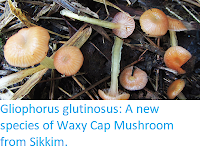Stinkhorns are gasteroid Basidiomycote Fungi (Basidiomycote Fungi with spores that develop inside their basidiocarps, rather than on the surface), found throughout the tropical, subtropical regions of the world. These Fungi produce foul-smelling, phallic-looking Mushrooms, which has given them mystic implications in the folklore of many cultures. At least 31 species of Stinkhorn are found in China, some of which are eaten, and even grown commercially. However, the exact taxonomic status of these Chinese Stinkhorns is often unclear, for example, the species Phallus indusiatus has been reported in south and southwestern China since the 1960s, but modern genetics-based taxonomic surveys have suggested that this species is restricted to South America, making the status of Chinese Stinkhorne populations given this name unclear.
In a paper published in the journal MycoKeys on 16 December 2021, Ting Li of the State Key Laboratory of Applied Microbiology Southern China at the Institute of Microbiology of the Guangdong Academy of Sciences, and the College of Science at Tibet University, Wang-Qiu Deng, Bin Song and Ming Zhang, also of the State Key Laboratory of Applied Microbiology Southern China at the Institute of Microbiology of the Guangdong Academy of Sciences, Mu Wang of the Tibet Agricultural and Animal Husbandry University, and Tai-Hui Li, one again of the State Key Laboratory of Applied Microbiology Southern China at the Institute of Microbiology of the Guangdong Academy of Sciences, describe two new species of Stinkhorns from south and southwest China, based upon populations previouslt assigned to Phallus indusiatus.
The first new species described is named Phallus cremeo-ochraceus, which refers to the ochre colour of its receptacle (mushroom-head). It has a white or slightly pinkish indusium (net-like structure that hangs from the rim of the receptacle) and pseudostipe (stem). The species was confirmed as new based upon genetic analysis of individuals collected from leaf litter in a Bamboo grove in the Xiaoqikong Scenic Area in Libo County, Guizhou Province, in July 2020.
The second new species is named Phallus rigidiindusiatus, which refers to the ridged nature of its indusium, which is particularly thick, and therefore rather stiff. This species was found growing in soil in broad-leafed forests and Bamboo groves, at a number of locations in Guangdong, Hunan, and Guizhou provinces.
See also...








